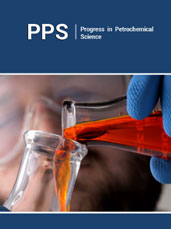- Submissions

Abstract
Progress in Petrochemical Science
Carbon Capture and Storage: An Artificial Lung Facing the Climate Crisis in Egypt
-
Open or CloseAjay C*1, Sohan Kumar Kanrar1, Saikat Das Gupta1, Rabindra Mukhopadhyay1, Dipankar Chattopadhyay2 and Mahuya Das3
1 Hari Shankar Singhania Elastomer and Tyre Research Institute, India
2 Department of Polymer Science and Technology, Calcutta University, India
3 Greater Kolkata College of Engineering and Management, India
*Corresponding author:Ajay C, Hari Shankar Singhania Elastomer and Tyre Research Institute, Mysuru, 570016, India
Submission: August 19, 2025; Published: September 26, 2025

ISSN 2637-8035Volume7 Issue 3
Abstract
Rubber vulcanizates are essential in many industries due to their elasticity, durability and flexibility. Their mechanical properties, especially their stress-strain behavior, depend largely on the vulcanization process, which strengthens rubber by forming cross-links between molecules. Among the key factors in this process, cure time plays a major role in determining the final strength and flexibility of the rubber vulcanizates. While previous research has examined the effects of cure time and strain rate separately, their combined impact is not yet well understood. This study investigates how Natural Rubber (NR) and Styrene Butadiene Rubber (SBR) behave under different strain rates and cure times. The results show that stress at 300% elongation increases with both strain rate and cure time, but at higher strain rates, stress stops increasing, showing a strain-hardening limit. Breaking elongation decreases as cure time increases because the vulcanizate becomes stiffer, while strain rate has a small influence on elongation. Based on these observations, mathematical models were developed to predict stress at 300% elongation and breaking elongation using power-law and nonlinear relationships. These models proved highly accurate, with R² values above 0.94, confirming their reliability in predicting rubber behavior. The study provides useful insights into how strain rate and cure time affect rubber properties, helping to improve material design and performance. The developed models can be used to optimize rubber processing and ensure better mechanical performance in industrial applications.
Keywords:IStress-strain; Crosslink density; Cure time; Fatigue; Universal testing machine
 a Creative Commons Attribution 4.0 International License. Based on a work at www.crimsonpublishers.com.
Best viewed in
a Creative Commons Attribution 4.0 International License. Based on a work at www.crimsonpublishers.com.
Best viewed in 







.jpg)






























 Editorial Board Registrations
Editorial Board Registrations Submit your Article
Submit your Article Refer a Friend
Refer a Friend Advertise With Us
Advertise With Us
.jpg)






.jpg)














.bmp)
.jpg)
.png)
.jpg)










.jpg)






.png)

.png)



.png)






